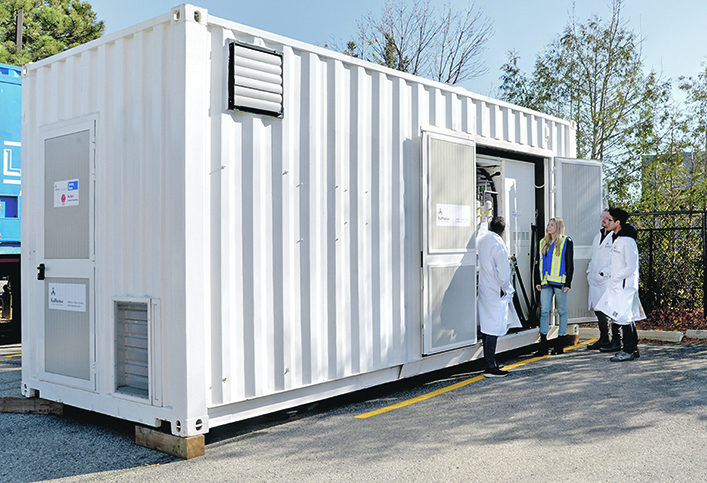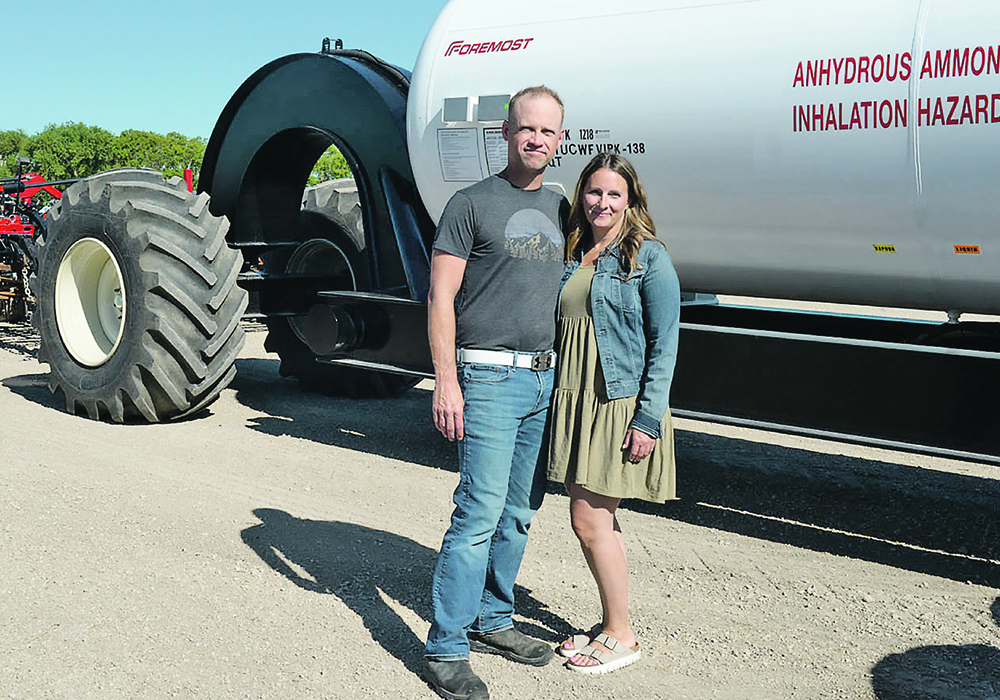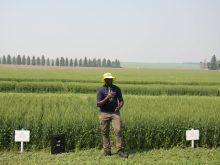This fall, anhydrous ammonia prices were at $1,900 per tonne on the Prairies. That’s up from $1,100 per tonne in the fall of 2021.
Given the eye-watering cost of anhydrous and other nitrogen fertilizers, it’s a good time to promote and sell a product that allows farmers to acquire ammonia at a lower cost.
One such product is a technology that allows them to produce their own anhydrous ammonia — on their farms.
FuelPositive, a company from Waterloo, Ont., has developed a “containerized green ammonia production system,” which converts electricity into hydrogen and then combines the hydrogen with nitrogen to produce ammonia.
The company has been testing and refining its system for months, but in a few weeks, possibly in January, FuelPositive intends to manufacture anhydrous ammonia at a farm southwest of Winnipeg.
“We are still planning to have the system on-farm early in the new year — and turned on,” said Ian Clifford, FuelPositive chief executive officer.
“As soon as it’s on site, we can commission it and get it fully operational…. We’ll be producing all winter and storing it all winter.”
In April, FuelPositive announced a partnership with Curtis and Tracy Hiebert, who run an 11,000 acre grain farm near Sperling, Man. The company will test and demonstrate the technology on their farm.
Curtis said it’s challenging to run a grain farm when fertilizer prices are unstable and unpredictable.
“We’ve had issues in the past few years where we were waiting for anhydrous ammonia in the field because our retailer didn’t have it in stock,” he said.
“We’ve also seen huge price increases. We pre-bought our ammonia for this fall at around $1,200 a tonne, and I understand that the price is double that now…. It’s scary. The FuelPositive system will give us stability. That’s what we like about it. It’s stabilizing the supply and stabilizing the price.”
Once the demonstration system is installed, FuelPositive will operate on the Hieberts’ farm for a year in “different weather and operational conditions,” the company’s website says.
While that is happening, the company is taking orders for more systems, which are sold at a base price of $950,000.
The target market, for now, is farmers and fertilizer.
“We’re already taking orders…. We’re getting interest from all over the world,” Clifford said.
“(And) there are a lot of farmers out there who want to see the system working on the Hieberts’ farm. They want to kick the proverbial tires.”
Almost all of the nitrogen fertilizer applied to farmland in North America is produced at large-scale plants such as the Koch fertilizer facility in Brandon.
The main input for those plants is natural gas.
“You take natural gas through a process called steam-methane reforming, essentially to get to the hydrogen,” said Mike Reese, renewable energy director at the University of Minnesota’s West Central Research and Outreach Center in Morris, Minn.
“That’s performed (at) world-scale plants … (and) one percent of global greenhouse gas emissions are attributable to ammonia nitrogen fertilizer production. I think it’s closer to two percent.”
The fertilizer industry is looking for ways to cut those emissions by storing carbon dioxide in the ground or switching to renewable electricity. Some in the industry describe it as green ammonia and blue ammonia:
- Green is hydrogen and ammonia produced with renewable energy.
- Blue is hydrogen and ammonia produced from natural gas, but with carbon capture.
“Blue is when you’re producing via a more traditional route … (and) you’re capturing the carbon dioxide and storing it underground,” said Chris Mancinelli, a chemical engineer with Casale, a Swiss engineering company that designs ammonia plants.
“There’s a lot of projects that are going to move quickly on large-scale blue hydrogen.”
However, big firms are also investing in green hydrogen. On Dec. 8, Air Products and the AES Corp. announced plans to build a US$4 billion green hydrogen plant in Texas.
FuelPositive and other companies are pushing a different model, in which fertilizer production is small-scale and decentralized.
“We’re direct to consumer…. saying the end user is the farmer. And the end user should have control over that input, entirely,” Clifford said.
“Our model is completely disrupting to the existing… ammonia manufacturing and distribution (model).”
The green ammonia model is largely based on electrolyzers, which use electricity to break water into hydrogen and oxygen.
The FuelPositive system uses a nitrogen generator to produce nitrogen from air and “an ammonia synthesis converter” to produce ammonia from the nitrogen and hydrogen, its website says.
In June, the company announced that it filed for a U.S. patent on its Modular Transportable Clean Hydrogen-Ammonia Maker.
In early December, Clifford spoke to The Western Producer from his home near Baddeck, N.S., on Cape Breton Island. He moved there with his wife, Luna in 2021, leaving Montreal for a calmer pace of life.
More than 25 years ago, Clifford founded an internet marketing company called digIT Interactive, which he sold in 2000.
Following that venture, Clifford got involved with electric cars.
“About 15 years ago, I started an electric car company called ZENN,” he said.
“We were producing low-speed electric vehicles … but we were way early in the curve.”
Clifford promoted the vehicle as an inexpensive electric car for markets such as California and Florida. The cars reached speeds of 45 km-h.
The ZENN (Zero Emission No Noise) car didn’t make it. The company stopped manufacturing the vehicle at its Quebec plant in 2009, and Clifford stepped down as chief executive officer in 2011.
But he didn’t give up.
He still wanted to develop a disruptive business that would benefit the planet.
An opportunity came several years ago when he met Ibrahim Dincer, a mechanical engineering professor from Ontario Tech university. Dincer invented the green ammonia technology that FuelPositive is now marketing.
Dincer’s invention and the concept of farmers producing their own fertilizer made an impression on Clifford, who grew up on a farm near Creemore, Ont.
“I have some background in agriculture…. We’ve had a family farm since the late ’50s…. My father, who was an architect, saw himself as a farmer more than anything else,” Clifford said.
“I learned about farming … and developed a real appreciation for the challenges of the sector. Looking at a technology that was as disruptive as basically turning the fertilizer industry upside down, and letting farms have that level of independence and control … just resonated with me.”
Since founding FuelPositive, Clifford and his team have been raising money and working to get the technology to market. The publicly traded company is listed on the TSX Venture Exchange.
Now that the demonstration project in Manitoba is nearly ready to launch, Clifford has been exceptionally busy.
He was in Kitchener-Waterloo, Ont., the day before a telephone interview with the Producer.
Before that, he was in Winnipeg and New York City.
FuelPositive chose Manitoba for the site of its first demonstration project for three reasons:
- Anhydrous ammonia is a commonly used fertilizer in Manitoba, so there is no learning curve for farmers.
- Manitoba’s main source of energy is hydro-electricity and the province has a “green” energy grid.
- The price of electricity in the province is relatively low.
“The Manitoba grid … is anywhere from four cents to 6.5 cents per kwH delivered to the farm,” Clifford said.
“It’s right in the sweet spot of energy costs to produce anhydrous at a highly competitive rate per tonne.
The cost of electricity is critical because separating hydrogen from water is the most expensive part of the FuelPositive system. Electrolyzers are pricey and require a significant amount of power to break the bond between hydrogen and oxygen in water.
“The electrolyzer is the largest contributor to the system’s operating expenses and capital expenses, representing over 80 percent of the system’s costs,” FuelPositive says on its website. “Its efficient operation has the greatest impact to the performance of the overall system.”
Despite that challenge, FuelPositive says its system can produce ammonia at a cost of around $560 per tonne.
One stumbling block is that few provinces or U.S. states have energy grids that are green.
Clifford said a pre-requirement to buying a FuelPositive system is having access to a green grid or “the willingness and commitment to installing renewables on-farm.”
But what happens if a Saskatchewan farmer doesn’t have access to “green” electricity? Clifford said they would need solar panels, a wind turbine or geothermal power.
“Our company is built around the idea that we’re creating carbon-free nitrogen fertilizer,” Clifford said.
“Otherwise, we’re really not doing anything for (the environment).”
However, producing fertilizer from wind or solar power can be challenging because it’s not always windy and many days are cloudy.
Would a farmer need to shut down the plant on calm days and restart it when it was windy? Or would the facility need a back-up power supply so the plant could be run continuously?
If the back-up supply of electricity comes from coal power, then the ammonia from the system is no longer “green.”
One workaround could be hooking up to the energy grid and buying renewable electricity from the utility. Most utility companies rely on a mix of energy sources, such as wind, coal, natural gas and hydro-electricity.

Another issue is operation and maintenance.
Farmers already have many pieces of equipment, so maintaining a fertilizer production system as well is a lot to ask.
FuelPositive has designed its system so that’s not an issue, Clifford said.
“It’s one of the core concerns we had, as we were designing the system,” he said.
“We wanted to make sure that having a FuelPositive system on the farm wasn’t adding to a farmer’s workload…. The design is that the system is fully monitored and can be controlled remotely by us.”
That means it can be turned on or off remotely, and system maintenance can be done at a central location, perhaps at the company’s headquarters in Waterloo.
Some tasks will need to be done on the farm, such as changing filters.
Looking ahead to next year, FuelPositive will continue to take orders and plans to manufacture the container systems at a plant in Waterloo.
“As batch sizes increase, we expect serial manufacturing (assembly line-style) will begin in another much larger facility we are building in late 2023,” its website says.
One roadblock could be the electrolyzers. Demand for them is massive and growing rapidly because of the investments in green ammonia.
“There’s all these people looking at this (green ammonia), but where are these electrolyzers going to come from?” said Mancinelli.
“The capacities for the electrolyzers (to produce hydrogen) is behind some of the ambitions (for) the projects going on.”
There will be obstacles, but FuelPositive envisions a future with hundreds or thousands of on-farm ammonia production systems in North America and around the globe.
For Clifford, it simply makes sense to produce zero-carbon fertilizer on the farm where it will be used.
“Taking a huge ammonia plant and de-carbonizing it is incredibly challenging,” he said, referring to the massive requirements for water and electricity to produce green hydrogen.
“This is why the de-centralized model is so attractive. The impact, site by site, is very, very low.”


















